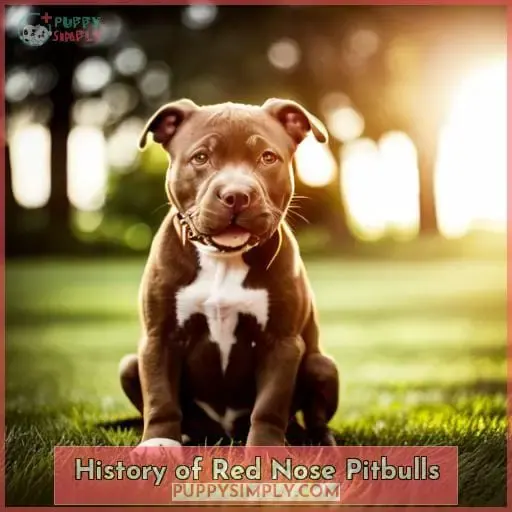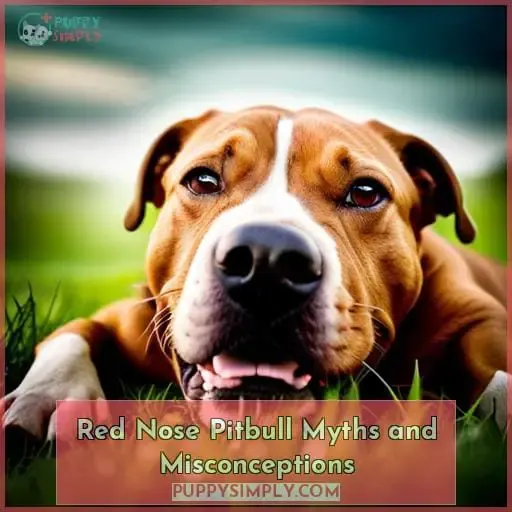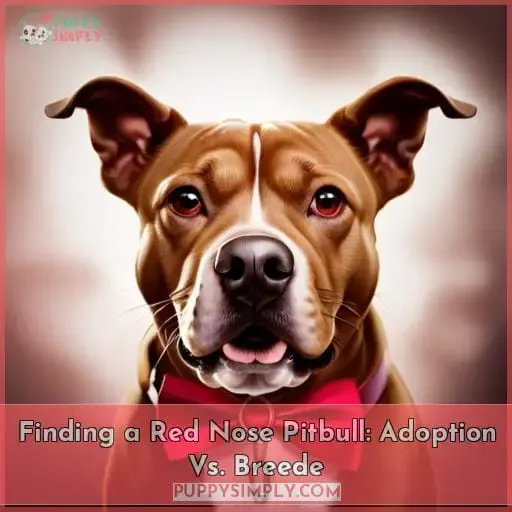This site is supported by our readers. We may earn a commission, at no cost to you, if you purchase through links.
 Discover the fascinating world of the Red Nose Pitbull and uncover their unique traits, rich history, and more.
Discover the fascinating world of the Red Nose Pitbull and uncover their unique traits, rich history, and more.
Contrary to popular belief, these intelligent and active dogs can be loving companions when properly trained.
Dive into their origins as working dogs with a long lineage of Old Family Red Nose strain in Ireland.
Find out about their distinct physical characteristics, temperament, health considerations, training needs, and debunk common misconceptions surrounding this misunderstood breed.
Whether you’re considering adding one to your family or simply curious about them – this article has got you covered!
Table Of Contents
- Key Takeaways
- History of Red Nose Pitbulls
- Physical Characteristics
- Temperament and Personality
- Health and Lifespan
- Feeding and Diet
- Training and Exercise
- Socialization and Family Life
- Red Nose Pitbull Myths and Misconceptions
- Legal Considerations and Breed Restrictions
- Finding a Red Nose Pitbull: Adoption Vs. Breede
- Frequently Asked Questions (FAQs)
- Are Red Nose Pitbulls aggressive and dangerous?
- Do Red Nose Pitbulls have specific health issues or genetic conditions?
- How much exercise does a Red Nose Pitbull need on a daily basis?
- Are Red Nose Pitbulls good with children and other pets?
- Are there any legal restrictions or breed-specific laws regarding Red Nose Pitbulls?
- Conclusion
Key Takeaways
- Red Nose Pitbulls are a loyal and affectionate breed that make great family pets.
- They are intelligent and eager to please, thriving with proper training and socialization.
- Red Nose Pitbulls have a stocky and athletic appearance, with distinctive reddish-brown fur, pink or red noses, and amber eyes.
- They have an average lifespan of around 10 to 14 years and require regular exercise and a balanced diet for their overall health and well-being.
History of Red Nose Pitbulls
The history of Red Nose Pitbulls dates back to the mid-1800s when they were bred in England.
These dogs came to the US with Irish immigrants and quickly gained popularity for their ferocity and gameness.
Red Nose Pitbulls are known for their loyalty and distinctive physical traits, such as a red, brown or copper color to their fur, lips, and toenails, along with amber eyes.
They’ve a rich history as working dogs in various roles including hunting game and guarding property.
Despite misconceptions surrounding this breed due to its association with dogfighting activities in the past, Red Nose Pitbulls are loving companions when properly trained and socialized.
Physical Characteristics
The physical characteristics of the Red Nose Pitbull are distinct and eye-catching.
They’ve a stocky and athletic appearance, with a wide chest, muscular build, and strong shoulders.
Their fur is typically red, brown, or copper in coloration and they often have patterns of white on their bodies.
With their striking amber eyes and powerful physique, Red Nose Pitbulls truly stand out among other dog breeds.
Appearance
With their stocky and athletic build, Red Nose Pitbulls possess a striking appearance that sets them apart from other breeds.
They’ve a wide and flat block head, deep barrel chest, broad strong shoulders, and a muscular physique.
Their coat is soft and smooth to the touch, adding to their overall appeal.
Red Nose Pitbulls come in various colors including red, brown or copper shades with patterns of white fur on their bodies.
Coloration
Continuing from their distinct appearance, Red Nose Pitbulls showcase a striking coloration that sets them apart from other breeds.
- Their name is derived from the reddish-brown hue of their fur, which extends to their noses and even their toenails.
- This unique coloration is determined by genetics and is specific to the breed.
- While red is the most common color, they can also exhibit variations such as brown or copper shades.
- Additionally, some Red Nose Pitbulls may have patterns of white fur on their bodies, adding further visual appeal to these magnificent dogs.
Coat Type
Transitioning from discussing the coloration of Red Nose Pitbulls, let’s dive into their coat type and physical characteristics.
The Red Nose Pitbull has a short, fine, and smooth coat that isn’t hypoallergenic.
Along with their distinctive red nose and copper-colored fur, they also have amber eyes.
Their coat type plays a role in daily life as it requires grooming maintenance along with an exercise routine and proper food and diet for optimal health.
Temperament and Personality
As we explore the temperament and personality of Red Nose Pitbulls, it’s important to note their friendly nature and strong bond with humans. These affectionate, loyal dogs crave attention and playtime. When properly socialized from a young age, they make wonderful family companions.
- Intelligent and eager to please
- Very protective of their owners
- Extremely playful and energetic
- Require proper training and socialization
- Prone to some health issues like hip dysplasia
While some still view them as dangerous, Red Nose Pitbulls respond incredibly well to positive reinforcement training and thrive when shown adequate love and care. Monitoring their diet is also key – both as puppies and adults, they need a balanced meal plan to support their high activity levels.
Ultimately, this breed makes for a delightful pet in the right home environment.
Health and Lifespan
Now let’s delve into the health and lifespan of Red Nose Pitbulls, exploring their overall well-being and how long they can live.
Red Nose Pitbulls have an average lifespan of around 10 to 14 years, but some can even reach up to 16 years with proper care.
These dogs typically weigh between 30 to 65 lbs, depending on their gender and individual genetics.
To keep them in optimal health, it’s important to provide them with regular exercise for at least one hour daily.
Additionally, a balanced diet that’s protein-rich should be provided to support their muscle development and overall energy levels.
With their friendly temperament and good physical condition maintained through exercise and nutrition, Red Nose Pitbulls can lead happy lives for many years.
Feeding and Diet
When it comes to your red nose pitbull’s nutrition, you’ll need to feed them properly as puppies and adults.
Focus on giving them high-protein, low-grain dry kibble suited for their age and size, dividing their daily portion into multiple meals.
Avoid unhealthy foods like grapes, chocolate, onions, and stick to a consistent feeding schedule.
Puppy Nutrition
When feeding your red nose pitbull puppy, you’ll want to start with dry kibble before they reach 6 months old, providing between 1⁄4 and 1⁄2 a cup daily divided into 4-6 meals.
As they grow older, transition to three meals per day.
Feed them high-protein foods without grains and avoid giving them certain harmful foods like garlic or chocolate.
Portion their food based on their size and ensure it consists of the right amount of protein and fat for their health.
Adult Nutrition
To properly nourish your adult Red Nose Pitbull, it’s essential that you provide them with a balanced and nutritious diet.
Feed your dog high-quality foods rich in protein, such as meat and low-grain options.
Avoid giving them foods like garlic, onions, chocolate or raisins which can be harmful to their health.
Determine the appropriate feeding frequency and portion sizes based on their size and activity level.
Consider incorporating supplements into their diet for optimal health.
Training and Exercise
As with any energetic breed, your Red Nose needs plenty of both mental and physical stimulation to thrive.
You should also:
- Brush their coat daily to remove dead hair and distribute skin oils
- Bathe them once a month or as needed to keep their coat and skin healthy
- Provide lots of social interaction to fulfill their needs for companionship
Additionally, Red Noses require substantial daily exercise of about one hour per day. Engage them in active playtimes and walks to meet their exercise needs. Mentally stimulate them as well through interactive games and teaching new commands.
Meeting both their physical and mental exercise needs will result in a happy, well-adjusted Red Nose Pitbull.
Socialization and Family Life
After proper training and exercise, it becomes apparent these pups thrive when surrounded by their loved ones. Their loyal and affectionate temperament pairs wonderfully when integrated into a family environment—especially in homes with children.
When raised alongside kids and properly socialized from a young age, Red Noses become the ultimate playmate. Shower them with the same gentle affection received, and they quickly transform into the loving, eager-to-please pet one dreams of.
While incredibly attached to their families, understand proper precautions are still needed despite their sweet dispositions.
When the unique needs of this loyal breed are met, the payoff found in their unwavering companionship makes them a perfect addition to households of all kinds.
Red Nose Pitbull Myths and Misconceptions
You’ve likely heard damaging myths about red nose pitbulls that simply aren’t true.
First and foremost, it’s important to clarify that not all pitbulls are red in color. Red Nose Pitbulls are just one variation of the breed, characterized by their distinct reddish-brown fur, pink or red noses, and amber eyes.
Contrary to popular belief, these dogs are friendly and not aggressive by nature. They possess a loyal and loving temperament towards their owners and can be great with kids when properly trained and socialized from an early age.
Furthermore, Red Nose Pitbulls are highly intelligent animals that excel in training sessions due to their eagerness to please their human companions.
Let go of any misconceptions you may have about this breed – they make wonderful family pets!
Legal Considerations and Breed Restrictions
Unfortunately, breed-specific legislation impacts responsible ownership of pitbulls in some areas. Additional costs and limited availability of the breed may also present challenges.
However, by staying informed and advocating responsibly, you can still provide a loving home for a red nose pitbull.
Breed-specific legislation impact
Certain Red Nose Pitbull bans severely limit your ability to own this breed in particular areas.
- Outright bans preventing ownership
- Restrictions like mandatory spay/neuter laws
- Requirements for muzzles, short leashes, and secure enclosures
These laws perpetuate negative stereotypes and unfairly discriminate against responsible owners. By understanding the challenges faced under breed-specific legislation, advocates can push for reforms emphasizing deed over breed.
Owning a pitbull
You’ll need to research your local breed-specific ordinances before bringing one of these pups home. Pitbull ownership comes with responsibilities around proper socialization, training, exercise, and preventing separation anxiety.
Invest time into positive reinforcement training and regular activity. Provide toys when alone to ease anxiety. Brush frequently to control shedding and groom regularly. Address health issues through proper diet, exercise, and veterinary care.
| Issue | Tips |
|---|---|
| Separation Anxiety | Provide interactive toys, gradually increase alone time |
| Shedding | Brush frequently with undercoat rake |
| Training | Positive reinforcement, reward calm behavior |
Cost and availability
Some areas have restrictions and bans against pitbull breeds, so you’re likely to face extra costs and limited options when acquiring a Red Nose Pitbull.
The average price for a Red Nose Pitbull puppy ranges from $500 to $1000, but prices can vary greatly depending on factors such as the breeder’s reputation and bloodline.
Additionally, the cost of adoption for a Red Nose Pitbull can range from $100 to $500.
If you’re looking for a show-quality dog with impeccable lineage, be prepared to spend anywhere between $1000 and $5000.
Finding a Red Nose Pitbull: Adoption Vs. Breede
When looking to bring a Red Nose Pitbull into your family, you have the choice between adopting from a shelter or going through a breeder.
Adopting from shelters and rescue organizations is often more affordable and provides an opportunity to give a loving home to dogs in need. Additionally, many shelters provide medical care and behavioral assessments for their animals before they’re adopted out.
On the other hand, going through reputable breeders allows you to select specific traits and characteristics that you desire in your Red Nose Pitbull puppy. However, it’s important to thoroughly research breeders to ensure they’re ethical and prioritize the health of their dogs over profit.
Keep in mind that purchasing from breeders can be more expensive than adoption fees at shelters.
Frequently Asked Questions (FAQs)
Are Red Nose Pitbulls aggressive and dangerous?
Red Nose Pitbulls aren’t inherently aggressive or dangerous. Like any dog, their behavior is influenced by training and socialization.
Do Red Nose Pitbulls have specific health issues or genetic conditions?
Red Nose Pitbulls can have health issues such as:
- Joint problems
- Skin conditions
- Retinal degradation
- Hip dysplasia
- Kneecap dislocation
- Degenerative myelopathy
It’s important to provide them with proper care and regular vet check-ups to ensure their well-being.
How much exercise does a Red Nose Pitbull need on a daily basis?
A minimum of one energizing hour filled with mentally and physically stimulating activity per day keeps your curious canine’s body fit and mind sharp.
Prioritize play that taps into their enthusiasm yet challenges their agility, like fetching balls or chasing squirrels at the park.
Ultimately, what matters most is that your faithful friend feels fulfilled.
Are Red Nose Pitbulls good with children and other pets?
Red Nose Pitbulls are great with children and other pets. They’ve a friendly and gentle nature, making them excellent family dogs. However, it’s important to socialize them from an early age to ensure positive interactions with kids and animals.
Are there any legal restrictions or breed-specific laws regarding Red Nose Pitbulls?
Unfortunately, yes. In some areas pit bull-type dogs face restrictions or bans due to breed-specific legislation over concerns about their reputation. But these laws are controversial and many argue breed alone doesn’t determine behavior – that proper training and socialization are key.
Conclusion
To sum it up, the Red Nose Pitbull is a fascinating breed with a rich history and unique traits.
Contrary to popular belief, these intelligent and active dogs can make loving companions when properly trained.
Their distinct physical characteristics and friendly temperament make them a great addition to any family.
With proper care and nutrition, they can lead a healthy and fulfilling life.
If you’re considering adding a Red Nose Pitbull to your family, remember to do your research and find a reputable breeder or consider adoption.
















